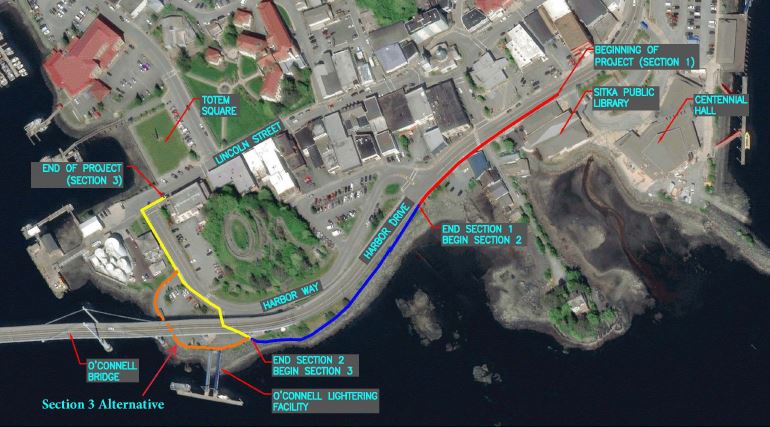
The Sitka Tribe of Alaska is concerned that a proposed extension of the Sitka Seawalk will destroy one of the few remaining cultural sites on the town’s waterfront.
The Tribe and the Sitka Assembly conferred on this and other matters during their semi-annual government-to-government meeting on Monday (2-13-23)
The Sitka Seawalk currently runs from Sitka National Historical Park to the Sitka Public Library. It’s a waterfront enhancement funded largely through the local share of the head tax on cruise passengers (Commercial Passenger Vessel Excise Tax) levied by the state.
A proposed extension of the Seawalk would create a new path around the outside of the O’Connell Bridge – essentially the last sliver of undeveloped waterfront in downtown Sitka.
State planners noted that rock fill for the proposed route would impact a bed of eelgrass in the area, considered essential fish habitat for herring. And there was also something else, as Jeff Feldpausch, the Tribe’s Resource Protection director, explained.
“They did find a man made rock wall that extends off that point, just from the base of the bridge kind of back towards the street or the road,” said Feldpausch. “I think the state had gone back through and did some additional testing. We were concerned that that rock wall was probably part of a clam garden.”
A clam garden is created by terracing a beach in an intertidal area with walls made from large stones. It’s a form of mariculture used by the indigenous peoples of the Pacific Northwest for millenia.

Tribal Council member Fred Olsen, Jr. noted the irony in that some places in Southeast were trying to enhance their waterfronts with recreations of nature or history (like the whale sculpture in Juneau), but Sitka had the real thing, and was putting it at risk.
“Instead of inventing something for tourists to look at, you have actual history to look at,” said Olsen. “And just don’t pave over that, you know.”
(Note: Tribal Council member Fred Olsen, Jr., is employed at KCAW.)
Sitka’s waterfront has been substantially modified and filled in over the years. Early in the last century, waves used to lap at the base of Castle Hill, and at the back of the stores along Lincoln Street. Now, most of the area from Crescent Harbor to Eliason Harbor has been filled in for streets and public buildings, like Harrigan Centennial Hall and the library. While the Seawalk doesn’t seem like a very big project relative to the overall development of Sitka’s waterfront, some Tribal Council members nevertheless felt very protective about what little of the natural environment remains.
Council member Marth Moses suggested that the construction of the Seawalk has already come with a cultural cost.
“When the Seawalk was being developed out to Totem Park and there was that little hill right there that had the huckleberries and the blueberries,” Moses said, “and when you had your elder go with you, you had a little trail that you could take your elder and they can go pick their own bucket. But that’s already blasted through. There’s a walkway through there, and that berry bush is gone. So when we talked about it at the Resource Protection (Committee), you make these developments and they’re gone forever. Our tradition is gone forever.”
Moses’ view was echoed by fellow council member Rachel Moreno, who said she worked in summer on cruise ships and interacted with passengers who were really interested to take in Sitka’s history, without creating harm.
“They want to know that they’re not having a negative impact where they visit,” Moreno said. “And if we just are so worried about creating a place for them to walk, without taking into consideration these historic sites and, and things that we grew up seeing – and gosh, we don’t see them anymore! I remember when Blueberry Hill was bulldozed for the Sitka – what’s there now? SAIL and the dental office. All us kids used to go up Blueberry Hill to pick berries, and that was a safe place to go. You know, we didn’t have to worry about bears or anything. And so that, because of development, is gone. That’s such a childhood memory. And I would hate to see one of the last parts of downtown Sitka that’s natural right now be destroyed.”
Scoping meetings were held in Sitka last fall on the Seawalk extension, and a public comment period was open through the end of the year. The state expects to have a 75-percent plan ready for public review by this coming spring or summer, as well as another public comment period. Mayor Steven Eisenbeisz told Tribal Council members that he’d be adding their concerns to those he’s already heard.
“Just being honest,” said Eisenbeisz, “I have heard a lot of negative on this Seawalk. So I think it is time for us to take a hard look at that project and determine if it is right for Sitka.”

The Sitka Tribal Council and Sitka Assembly meet twice a year for a meal, and to cover a joint agenda of issues important to each body (and have done so for the last 25 years, a fact which was noted at the meeting). Other major topics covered at their February meeting included collaboration on an Affordable Housing Summit this year – including homelessness – building redundancy into the community’s broadband infrastructure, and coordinating the strategic plans of the Tribe and the City.






























